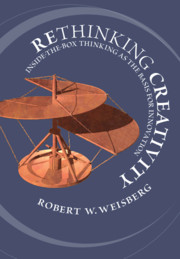Book contents
- Rethinking Creativity
- Rethinking Creativity
- Copyright page
- Dedication
- Contents
- Figures
- Tables
- Part I Introduction
- 1 Setting the Stage
- 2 Creativity
- Part II Analytic Thinking in Creativity
- Part III The Question of Extraordinary Thought Processes in Creativity
- Part IV The Psychometrics of Creativity
- Part V The Neuroscience of Creativity
- References
- Index
1 - Setting the Stage
Introduction to the Study of Creativity
from Part I - Introduction
Published online by Cambridge University Press: 01 October 2020
- Rethinking Creativity
- Rethinking Creativity
- Copyright page
- Dedication
- Contents
- Figures
- Tables
- Part I Introduction
- 1 Setting the Stage
- 2 Creativity
- Part II Analytic Thinking in Creativity
- Part III The Question of Extraordinary Thought Processes in Creativity
- Part IV The Psychometrics of Creativity
- Part V The Neuroscience of Creativity
- References
- Index
Summary
This chapter uses case studies of two seminal advances – the creation of a new shopping cart for ABC’s Nightline by IDEO, one of the most well-known design firms; and Picasso’s creation of Guernica, his great anti-war painting – to provide evidence for the importance of analytic thinking in creativity. The chapter also presents the main themes that structure the discussion in the book. The first is that creative thinking and ordinary thinking are the same. There is no special kind of thinking – no outside the box thinking – which serves in the creation of new ideas. Second, the creative process can be analyzed into two large stages: the generation of a possible idea, based often on analogical thinking; and the attempt to extend that idea to the new situation. Third, creative thinking, since it is analytic or ordinary thinking, is conscious thinking. Finally, in order to understand creativity, we need enough information to allow us to dig deeply into the underlying psychological processes. One cannot assume that one understands the processes involved: one must obtain evidence for any claims about how the creative processes works.
Keywords
- Type
- Chapter
- Information
- Rethinking CreativityInside-the-Box Thinking as the Basis for Innovation, pp. 3 - 40Publisher: Cambridge University PressPrint publication year: 2020

